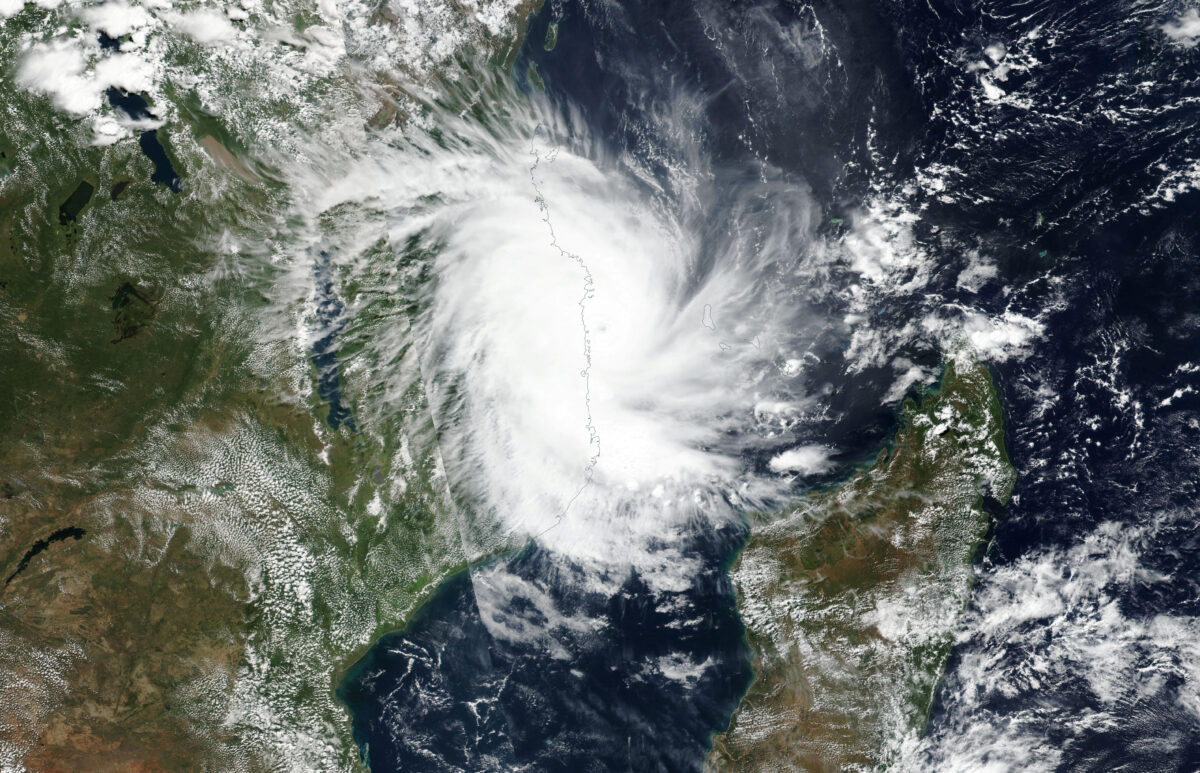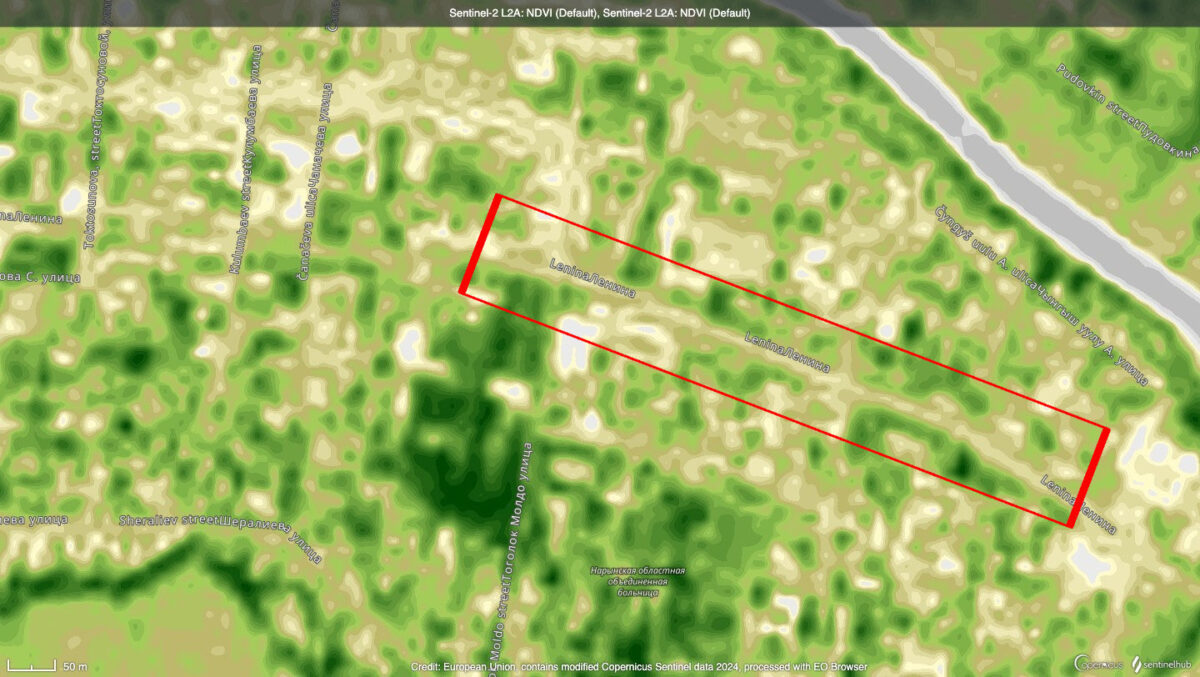How a Leaking Barge Became an Oil Spill Disaster Off the Tobago Coast
Satellite images newly obtained by Bellingcat shed light on how a stranded barge at the centre of a major oil spill ended up aground and leaking oil off the Tobago coast.
Bellingcat tracked the vessel, and the tugboat Trinidad and Tobago authorities identified as its seafaring engine, along an ill-fated, five-week journey using satellite imagery and Automatic Identification System location (AIS) data. Included on the trip was a visit to Pozuelo’s Bay, Venezuela while the vessel had gone dark by turning off its AIS transmissions, as first reported by Tanker Trackers, an independent service which tracks oil shipments around the world.
Pozuelo’s Bay is the site of a major port for the state-owned Petróleos de Venezuela (PDVSA) and is also used by PDVSA for ship-to-ship oil transfers. Imagery discovered by Bellingcat shows that the barge began leaking oil as early as February 3, immediately after leaving Pozuelo’s Bay, and that it appears to have capsized by the morning of February 6.
Tobago authorities have called on those responsible for the barge to come forward and face accountability. As of late last week, the oil slick resulting from the spill extended some 90 miles into the Caribbean.
Bellingcat previously identified the barge, which ran aground off the island’s coast earlier this month, as the Gulfstream, formerly affiliated with a tugboat called the Marlin. One crucial newly discovered piece of information, gleaned from Google Street View, is that the Gulfstream was quietly rechristened sometime before 2018. Its new name: the Sea Marlin.
Tracking the Barge’s Journey to Tobago
According to Trinidad and Tobago authorities, the Gulfstream was towed by a tugboat named the Solo Creed, on a journey that was bound for Guyana from Panama before it became stranded off the coast of the Caribbean nation. Using AIS data and satellite imagery, Bellingcat was able to follow the Solo Creed and Gulfstream on almost every day of their doomed voyage.
In early 2023, satellite imagery showed the Gulfstream docked in the city of Colón, Panama, near the Atlantic entrance to the Panama Canal. In June 2023, imagery from Planet Labs shows that the Gulfstream was moved from a pier known as Muelle 3 to an informal harbour just to the south, where it was laid up along a beach until the Solo Creed joined it and began the trip to Tobago. (For ease of understanding, we are referring to the Gulfstream by its longtime former name, as opposed to the Sea Marlin.)
A Planet Labs satellite image from December 30, 2023 shows the Gulfstream being pushed into the harbour by the Solo Creed. The Solo Creed’s position was verified with AIS data, while the distinctive notch and size of the Gulfstream is a visual match for the barge Bellingcat has previously reported.
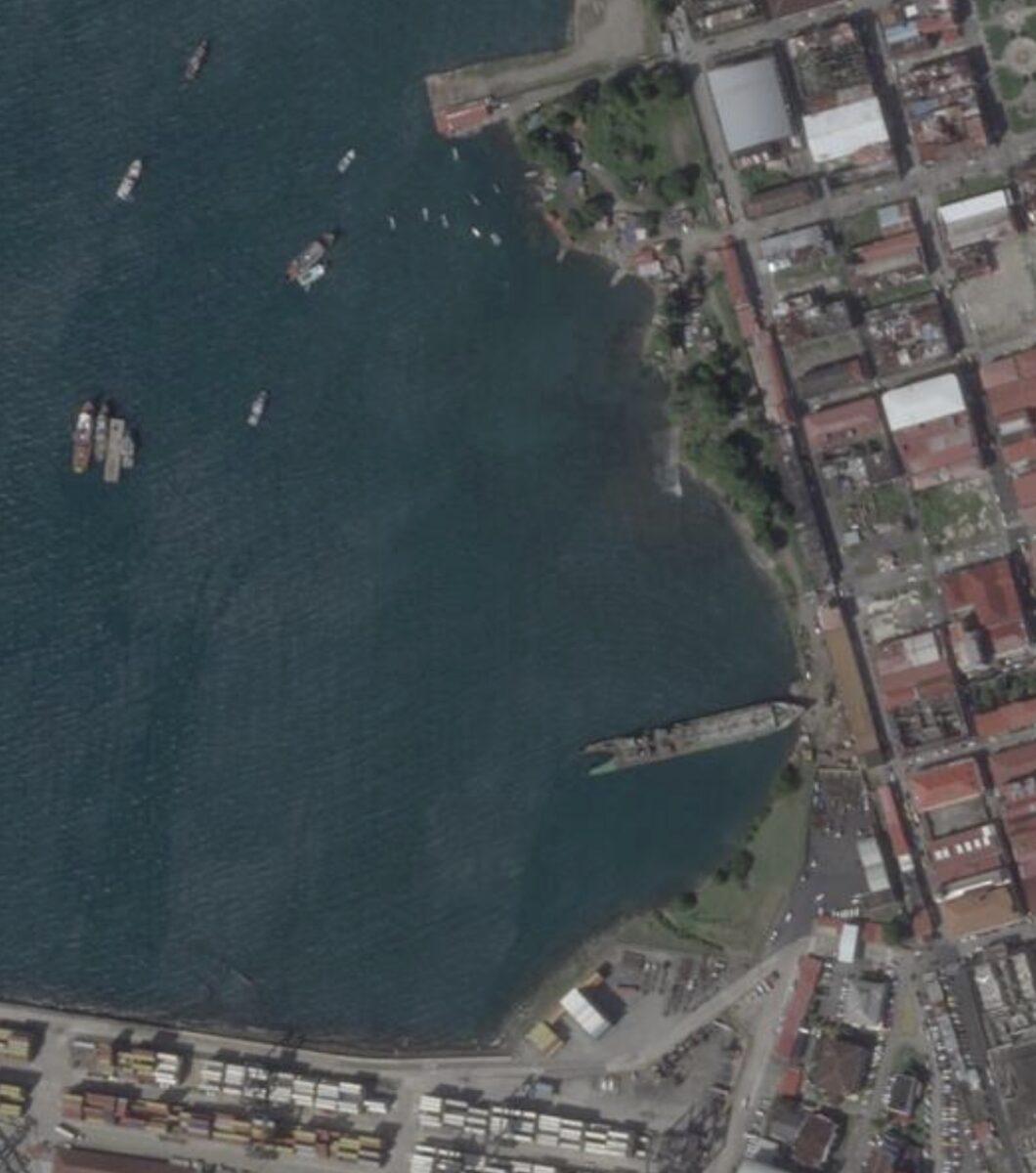

After spending a few days anchored off Colón, AIS data shows the ships began to travel east towards Venezuela. At this time, the Solo Creed switched from “towing alongside,” which is more manoeuvrable, to using a “long tow,” which is more efficient.
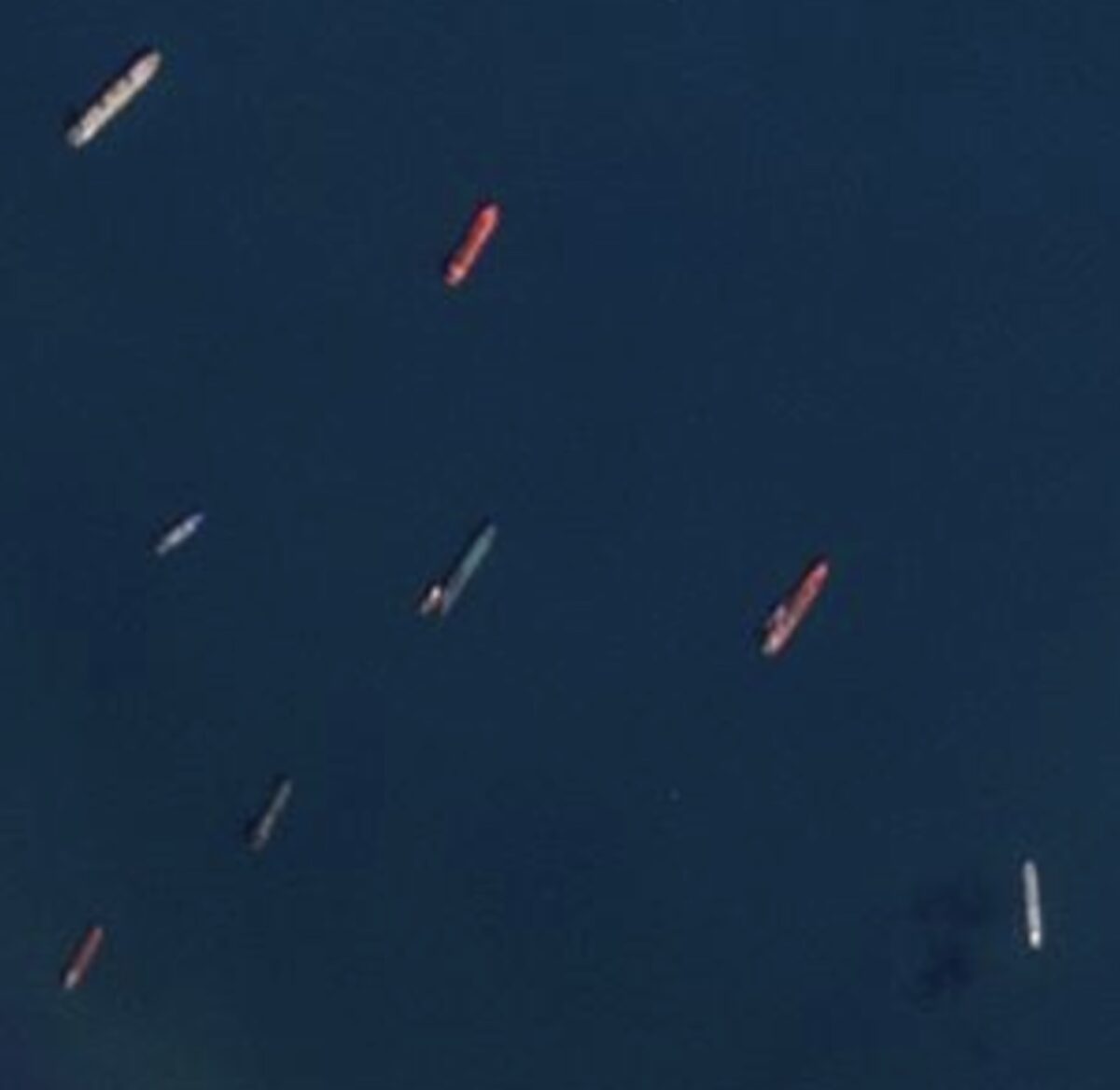

From January 17 to January 22, the Solo Creed and Gulfstream loitered offshore near Amuay, Venezuela. On January 18, they were captured by a Planet SkySat high-res satellite, seemingly tasked over open sea. The image is at a slight off-nadir angle that allows the side of the vessel to be seen, indicating that the Gulfstream was likely unladen at this time.
On January 22, the Solo Creed disabled its AIS system, according to publicly available data. AIS is a system whereby ships broadcast their positions via transceivers so that vessel traffic services can monitor their movements. Vessels stop transmitting AIS data for many reasons, some of which are legitimate, such as to address technical issues. However, the deliberate disabling of AIS without legitimate cause is considered a deceptive shipping practice.
The Solo Creed did not re-enable its AIS until February 4, at which point it had travelled about 375 nautical miles. According to Tanker Trackers, this distance would typically take about three days to travel.
Tanker Trackers located the Gulfstream in Pozuelo’s Bay, Venezuela, a major petroleum port, on January 26. While in Pozuelo’s Bay, the Solo Creed switched back to using a towing alongside setup. Bellingcat was also able to locate and visually match the Gulfstream near this location in Pozuelo’s Bay on January 27, 29, 30 and 31.
On February 3, after leaving Pozuelo’s Bay, imagery from Planet Labs PBC captured the barge and tug heading northeast, with the barge again on a long tow. Notably, the barge already appears to be leaking an oily fluid, leaving behind a slick that stretches for at least 40 kilometres.
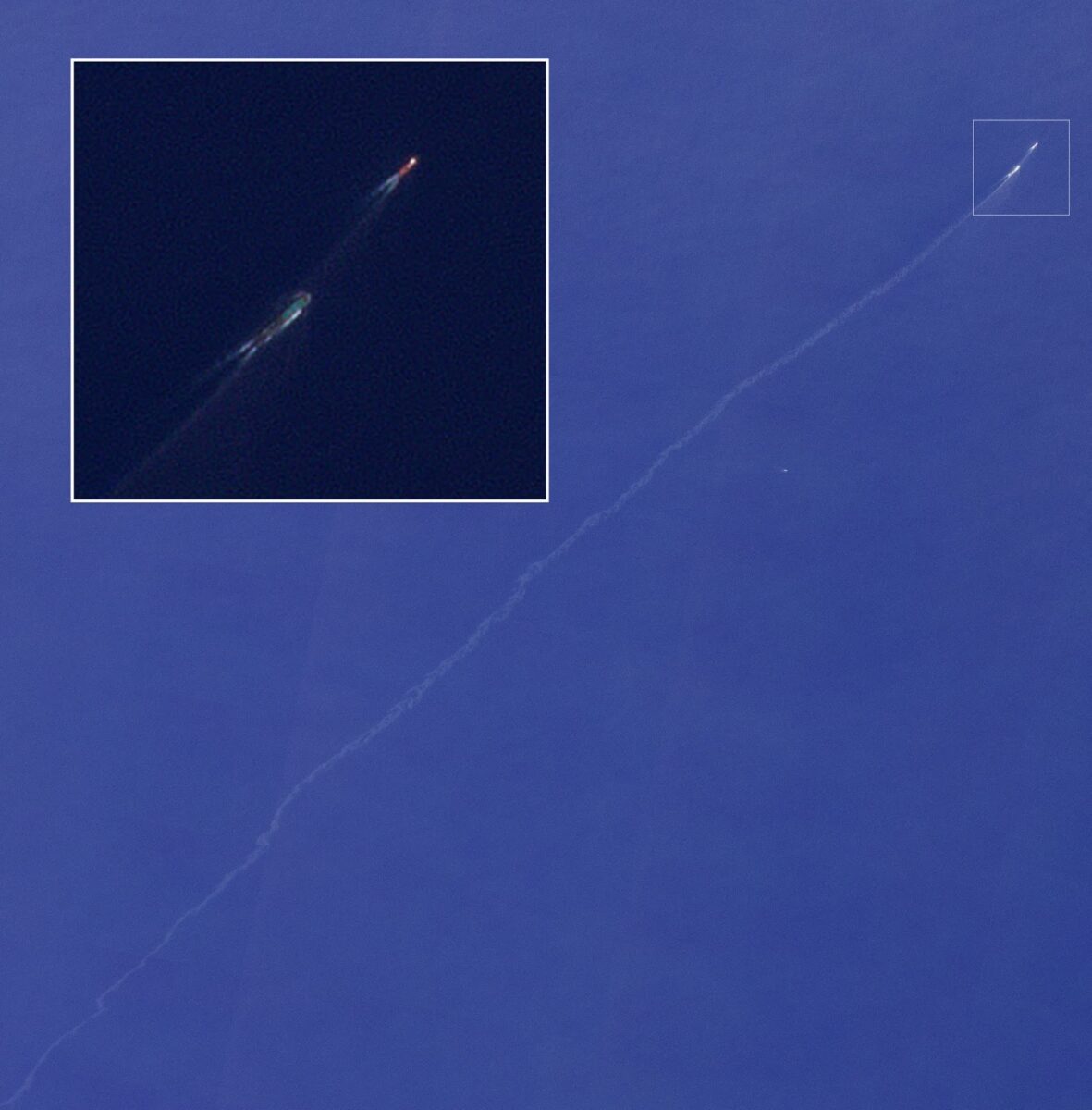
Such an oil trail could not be seen earlier, indicating that it is possible that the barge took on oil from Venezuela while in Pozuelo’s Bay. There are several major refineries of the PDVSA located there, and it is also a common location for ship-to-ship transfers, which can be used to surreptitiously avoid sanctions. While Bellingcat did not observe the Gulfstream docking or engaging in a ship-to-ship transfer in Pozuelo’s Bay, imagery was not available for every day. Sanctions on Venezuelan oil have been partially lifted since October 2023, and it is not clear why the Gulfstream would take measures to hide movements.
That the Gulfstream was likely already leaking oil on February 3 could indicate that something had already gone awry with the voyage or reflect the general level of maintenance of the vessel. Prior to this trip, it had spent eight months docked and then seven months beached along a stretch of undeveloped coastline used as an informal harbour in Colón.
The chief engineer of the Gulfstream from 1996 to 2010, Martin Malia, told Bellingcat in an interview that when it was previously operated by Penn Marine in the United States, the vessel had been used for carrying asphalt. He noted that asphalt must be kept heated in transport, and the frequent thermal cycling caused cracks to form in the cargo tanks. Malia also said that as the vessel aged these cracks became more common, contributing to Penn Marine’s decision to sell the Gulfstream.
On February 6th at 14:41 UTC, Planet Labs PBC imagery captured the Gulfstream seemingly capsized with a large oil slick around it, approximately 16 nautical miles southeast of Tobago.
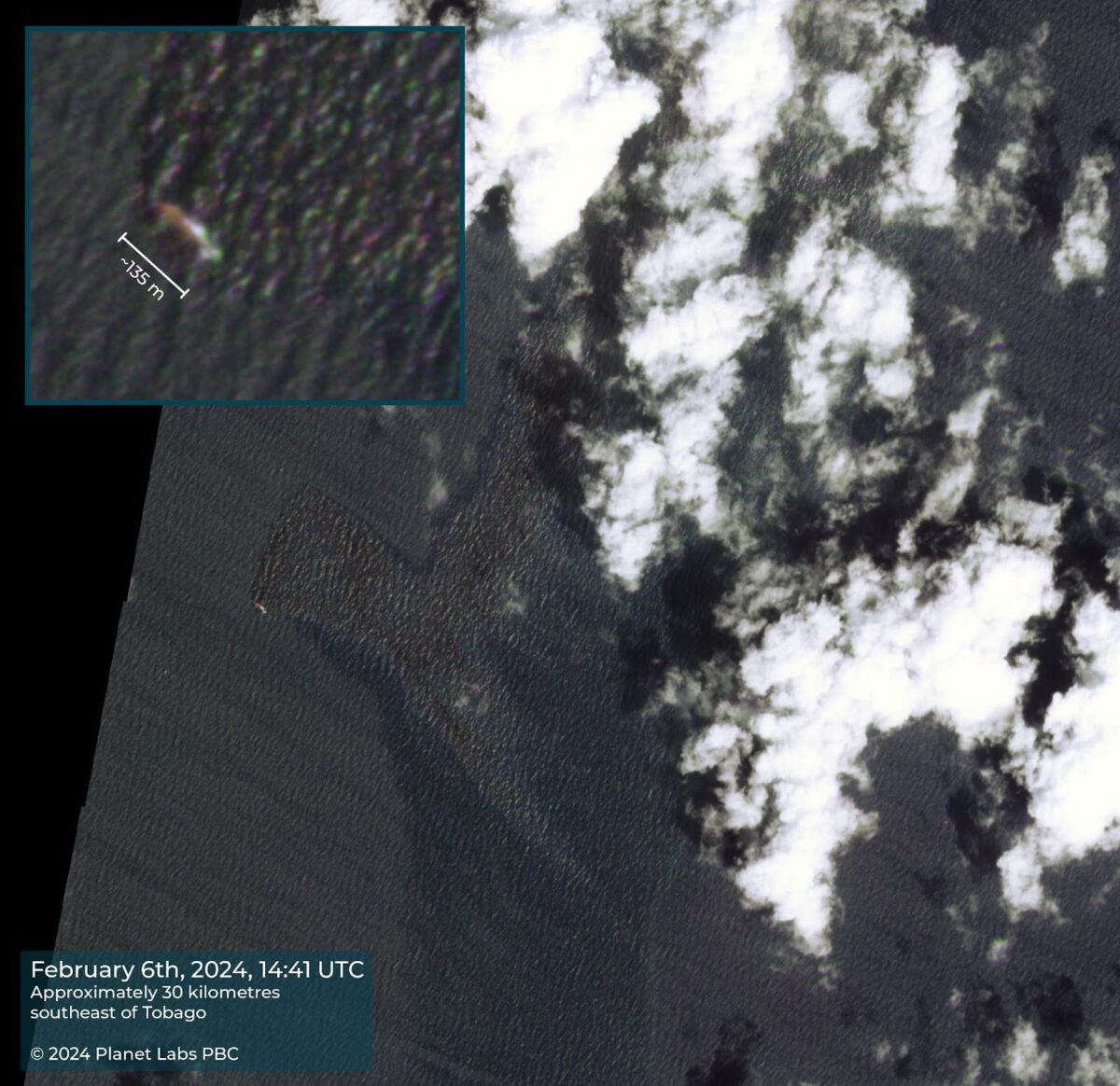
Over the following night, the barge drifted northwest until it ran aground on the reef at Cove, Tobago.
Bellingcat identified dozens of satellite images that show the Gulfstream and Solo Creed from December 30, 2023 until February 7, 2024. The full list of locations and dates is available on this Google Sheet.
The Gulfstream Becomes the Sea Marlin
As previously reported by Bellingcat, the Gulfstream and its married tug, the Marlin, were sold to the Panamanian company San Martin Group Ltd in October 2012. AIS vessel tracking data show that the Marlin travelled first to Colón, Panama, and then to Venezuela after this purchase, where it operated for several years, frequently visiting oil terminals owned by PDVSA.
In October 2020, AIS records show the Marlin and the distinctive Gulfstream arrived at the ASTINAVE shipyard in Amuay, Venezuela. In March 2021, records in the vessel ownership database Equasis show that the Marlin was sold to another Panamanian company, Star Goods Petroleum SA. Bellingcat previously reported that it was last seen near Amuay on February 22, 2022. Newly discovered open source information tells the rest of the story.
Satellite images from Planet Labs show that the Gulfstream barge arrived in Colón, Panama between September 13 and September 21, 2022. High resolution imagery available on Google Earth in October shows that it is the same Gulfstream barge last seen in February 2022 at ASTINAVE shipyard.
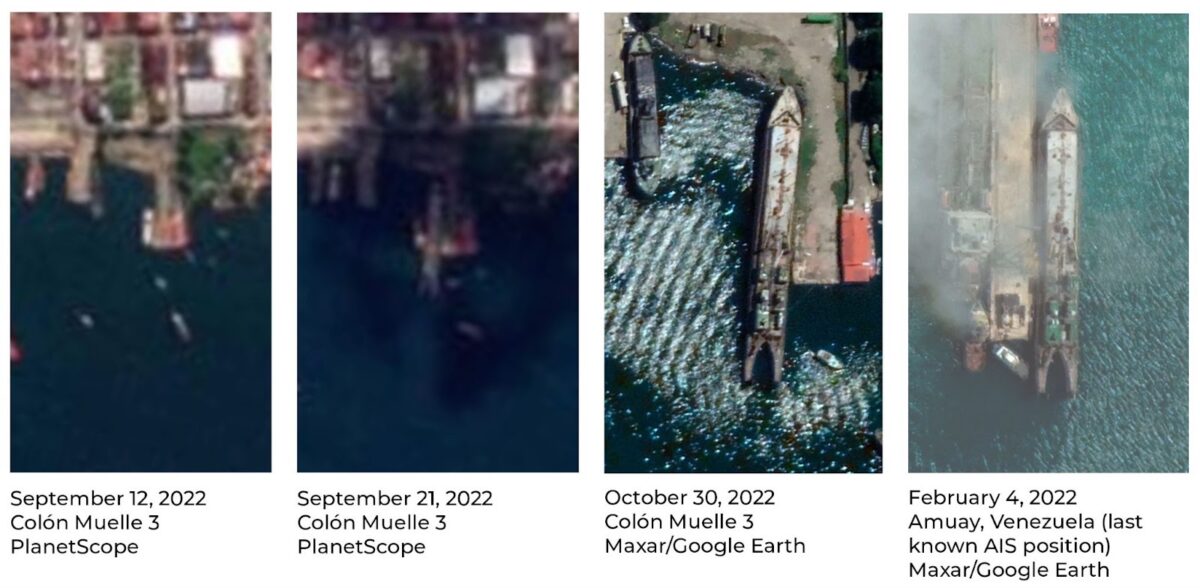
AIS data shows that a tug boat named the Sea Voyager (IMO 7417317) also arrived in the same time range and was active near the pier where the Gulfstream was docked.

Using AIS records, Bellingcat followed the Sea Voyager’s travel history and found that, in June 2022, it sailed from Colón to a place offshore from Amuay, Venezuela, before returning to Colón. Imagery from Planet Labs from June 10, 2022 shows the Gulfstream barge, without its former Marlin tug, floating near the Sea Voyager’s turn-around point. The distinctive notch in the hull is visible in satellite imagery, and this is near the ASTINAVE shipyard where the ship was docked until at least February 22, 2022.
The Sea Voyager is also visible at the location indicated by the AIS track. The Sea Voyager’s track shows that it returns to Colón with the Gulfstream, captured by Sentinel-2 imagery on July 3rd.
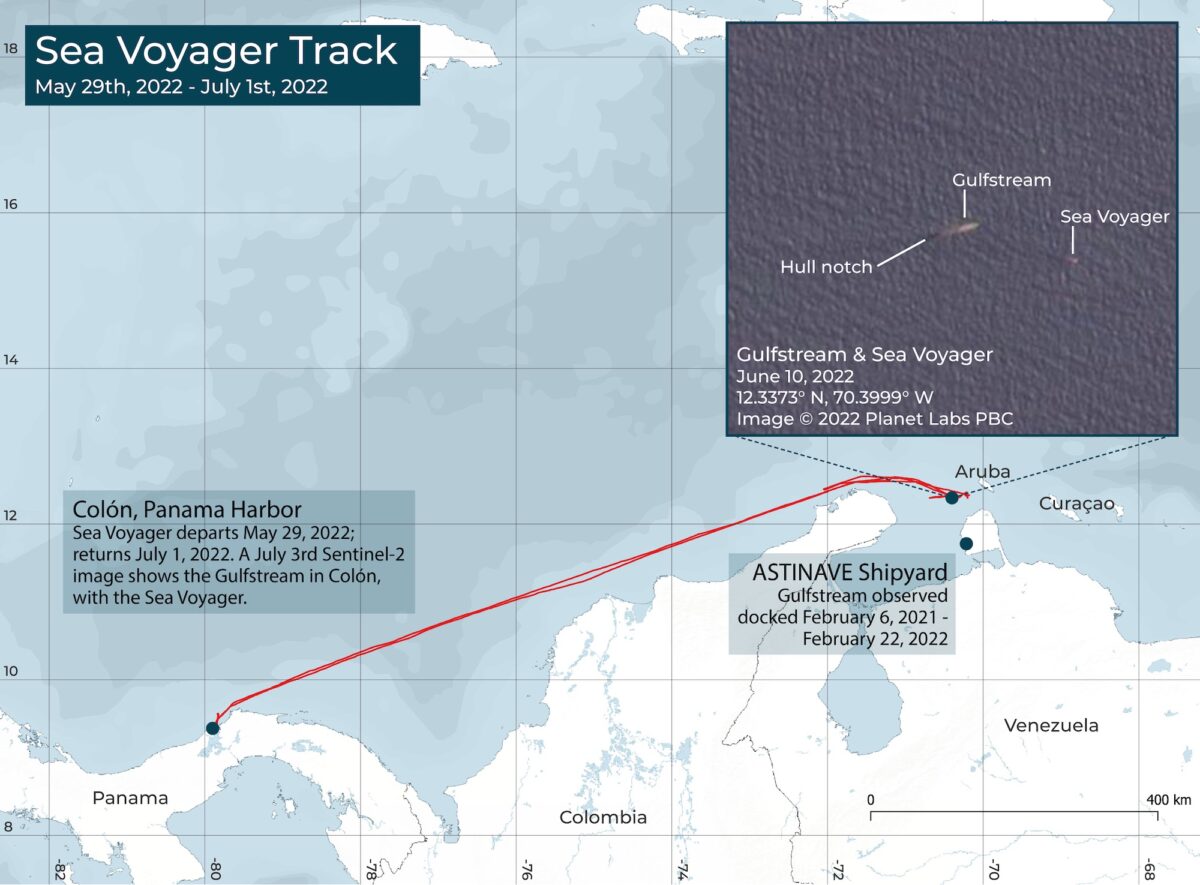
For the next several months, the Sea Voyager and Gulfstream operated offshore from Colón, Panama. AIS records suggest that they possibly engaged in bunkering or ship-to-ship oil transfers, one of which was caught by Planet Labs imagery on July 12, 2022.
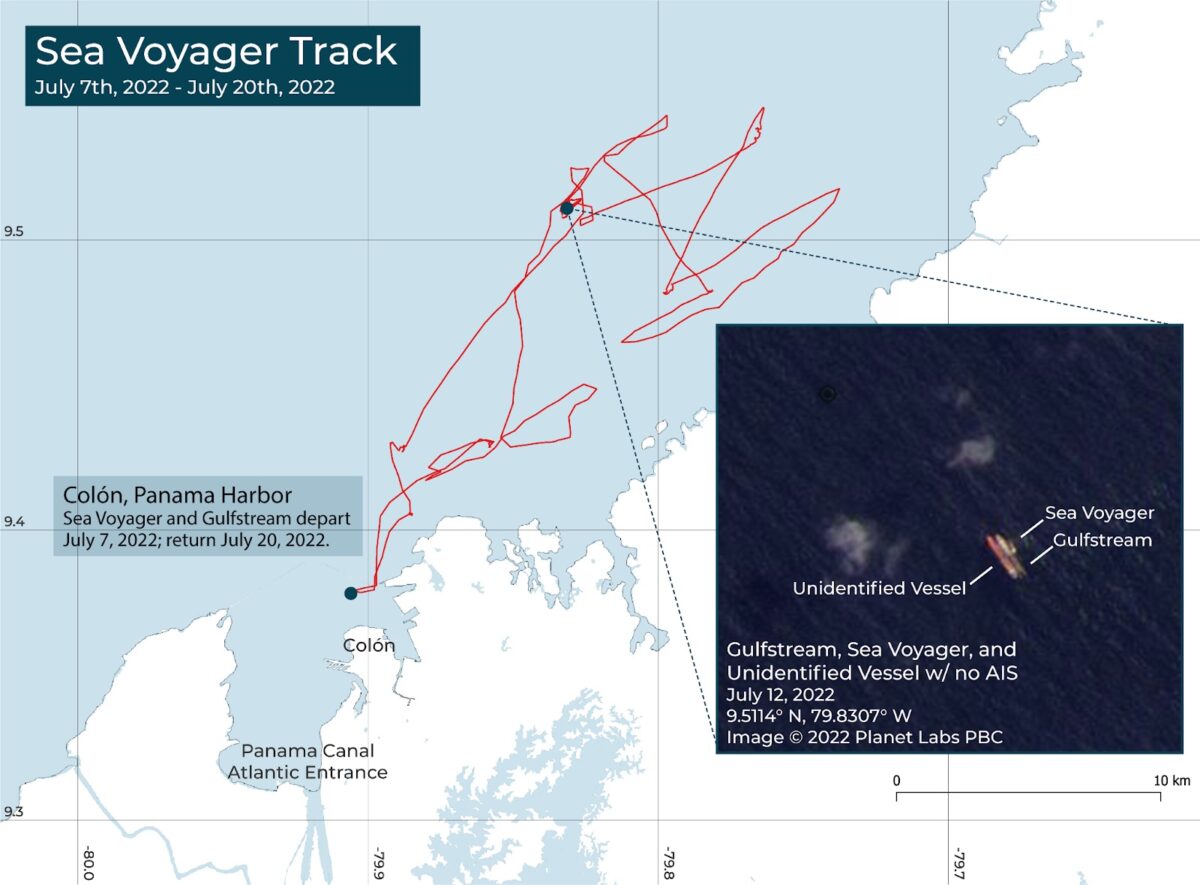
Finally, the Gulfstream and the Sea Voyager arrived at the pier named Muelle 3 in Colón on September 13, 2022. Ten days after arriving at Muelle 3, on September 23, the Sea Voyager changed its flag from Guyana to Tanzania. (The International Transport Workers’ Federation categorises Tanzania’s as a flag of convenience (FOC), a term for flags that vessels often sail under to avoid regulatory scrutiny; some experts have also identified Guyana’s as an FOC.)
A picture of Colón posted by David Stanley on Flickr shows the Gulfstream at its berth in Muelle 3. The image has EXIF metadata indicating it was taken on December 14, 2022, which is consistent with the timeline established by satellite imagery. The ship’s superstructure and characteristic vertical couplers near the notch at the stern match photos of the Gulfstream previously reported by Bellingcat.
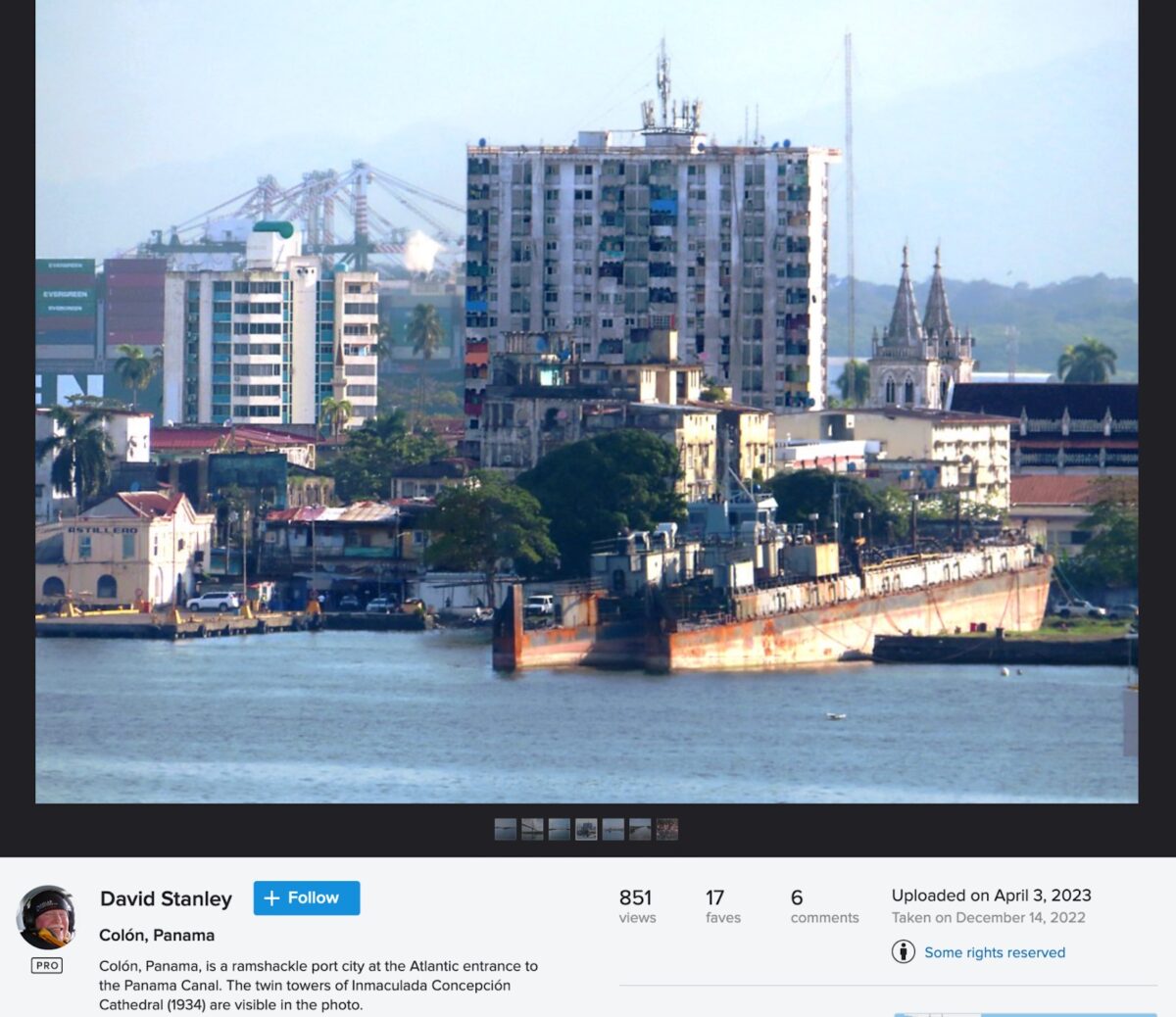
After it arrived in September, the Gulfstream stayed in Colón for the next 15 months, first at Muelle 3 and then beached along a stretch of coastline that appears to serve as an informal shipyard. The Sea Voyager continued to operate until January 2023, when it sank 50 nautical miles west of Cartagena, Colombia. Both the Sea Voyager and the Solo Creed are Tanzania-flagged tug boats previously operated by Crowley Maritime in the United States, and both were built in 1976. (Crowley did not reply to a request for comment).
Google Street View imagery from November 2022 photographed the streets surrounding Muelle 3. While the port terminal is surrounded by a high wall, part of the Gulfstream is still visible. Its new name, the Sea Marlin, can be seen, though it is partially obscured by a protective pole with barbed wire extending along the port terminal wall.
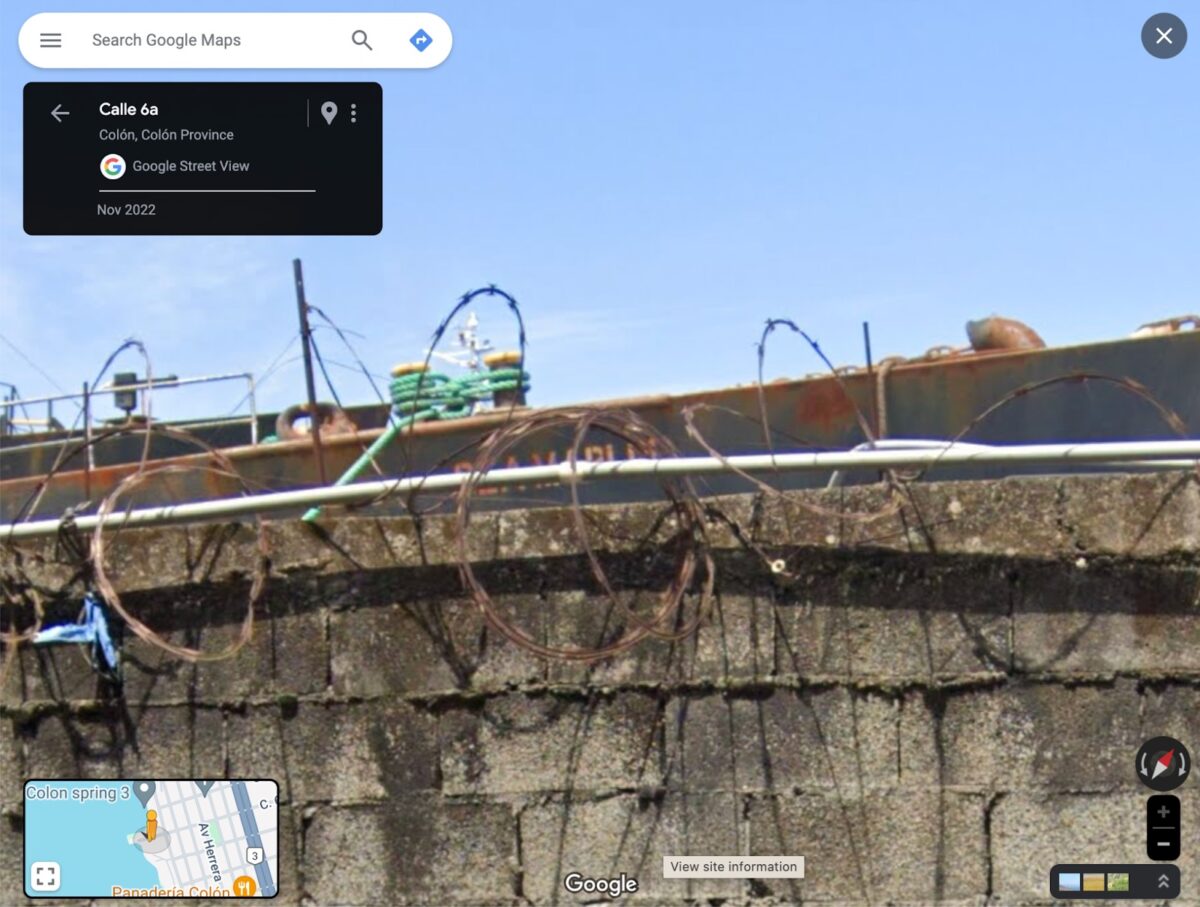
While the barge was now sailing under its new name, satellite imagery of the dock during November showing the vessel’s unique shape, and visual matches with the ship’s superstructure identify that it is the same barge previously known as Gulfstream. Additionally, the Maritime and Offshore Directory lists the Tug Marlin and the barge Sea Marlin under the same IMO number previously associated with the Marlin and Gulfstream.
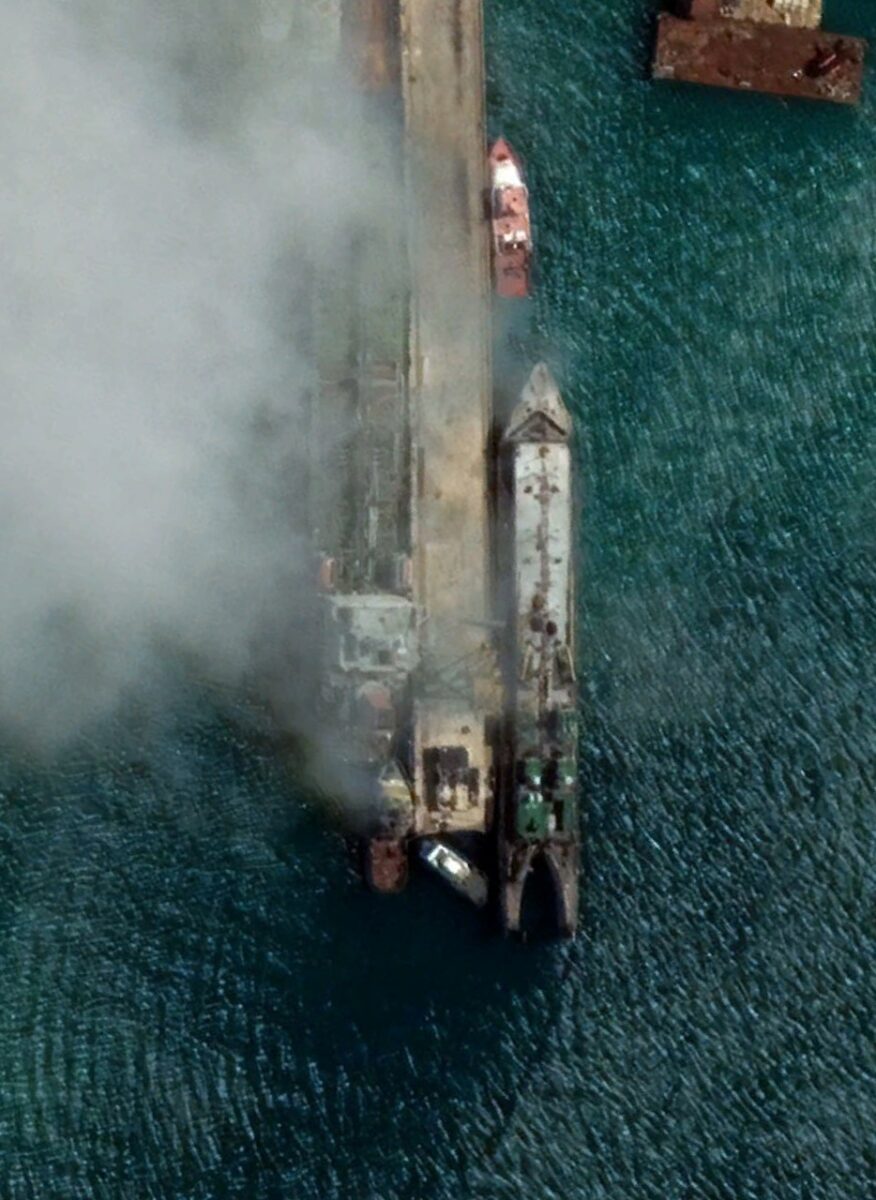
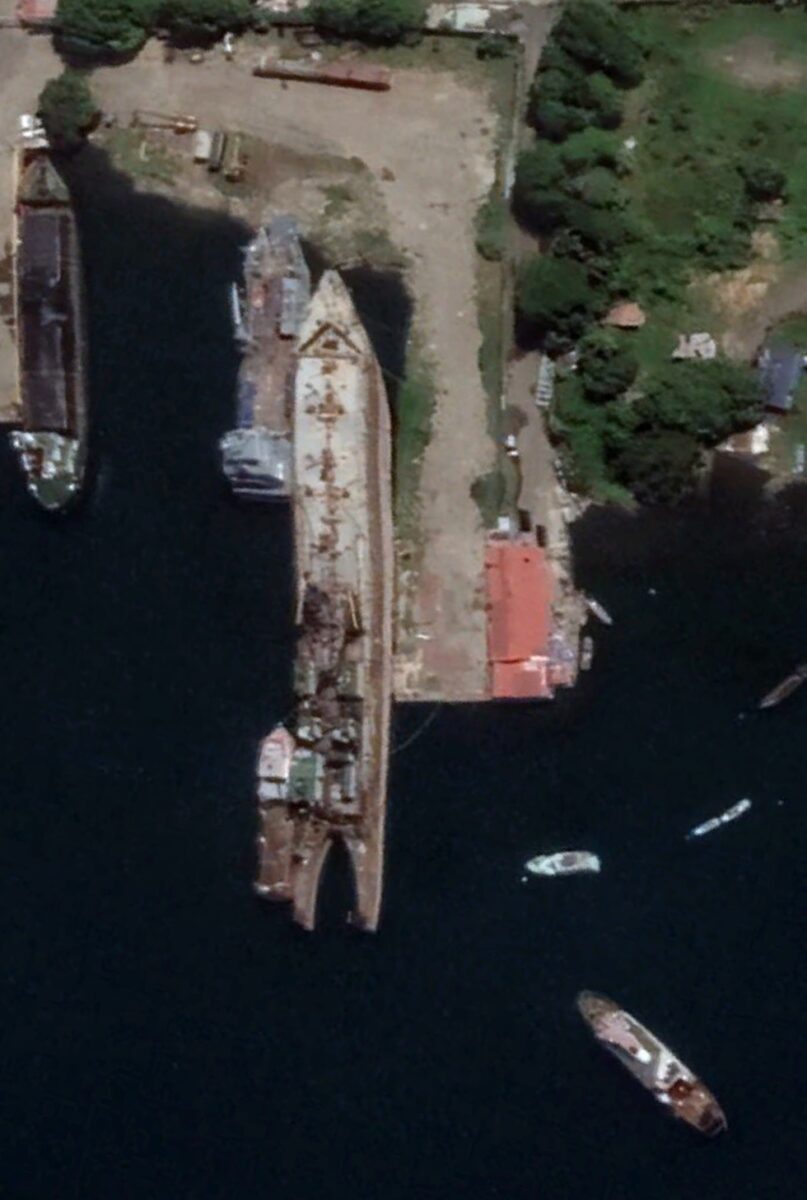
Video footage released by authorities in Tobago on Friday shows that the old name discovered by divers was written on the hull of the vessel in a weld bead.
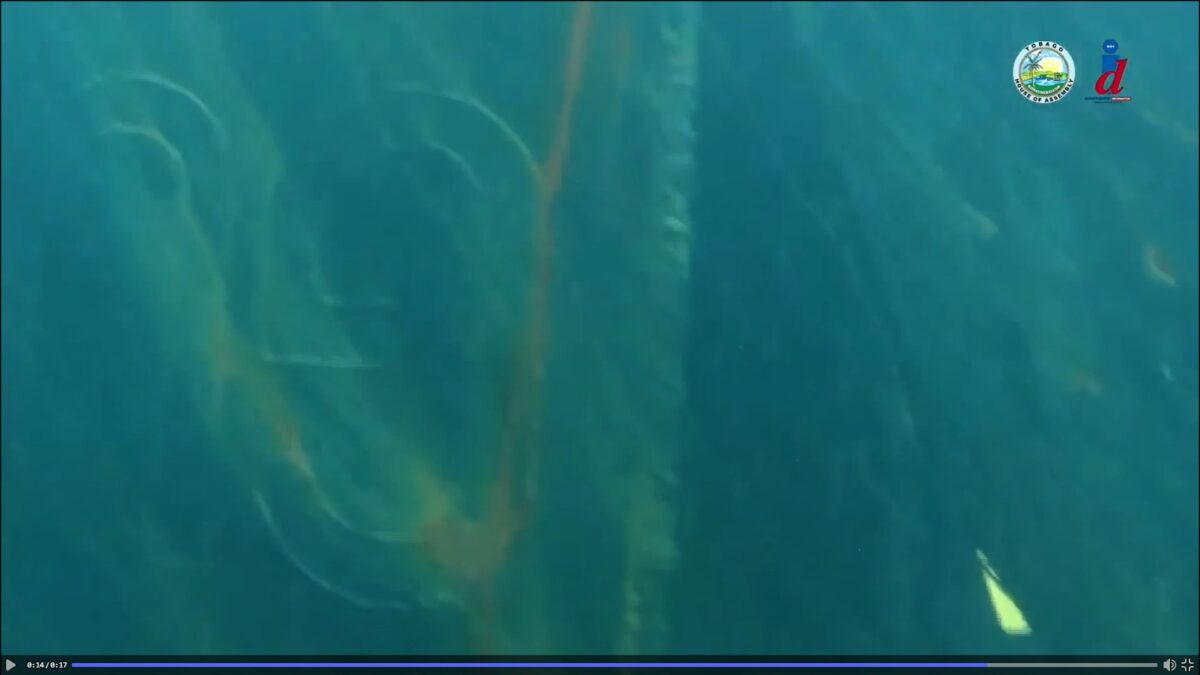
This means that, despite the name Gulfstream having been painted over when the vessel was renamed Sea Marlin, the original name remained welded onto the hull for divers to discover. It is unclear if the name Sea Marlin remains on the ship or if that, too, has since been painted over.
During a press conference on 14 February, Farley Augustine, the Chief Secretary of Tobago, said that Gulfstream “is perhaps an older name, the original name,” possibly because divers noted that the weld bead letters had been painted over.
Using the name Sea Marlin, Bellingcat connected the barge and its tug formerly known as the Marlin to a group of companies called Sea Energy Group. According to Panamanian business register data, the president of San Martin Group Ltd., the firm that acquired the Gulfstream in 2012, is Jorge Rincon. He is also a director at Sea Energy Group, according to his LinkedIn profile. Rincon did not reply to a request for comment, while Sea Energy Group’s website is now defunct.
In a post on LinkedIn from 3 September 2018, Sea Energy Group advertised their “three barges working together for you!” These include the Sea Lion, the Sea Light, and sandwiched between them the Gulfstream, now re-christened Sea Marlin, with its tug Marlin, now rechristened Tug Marlin.
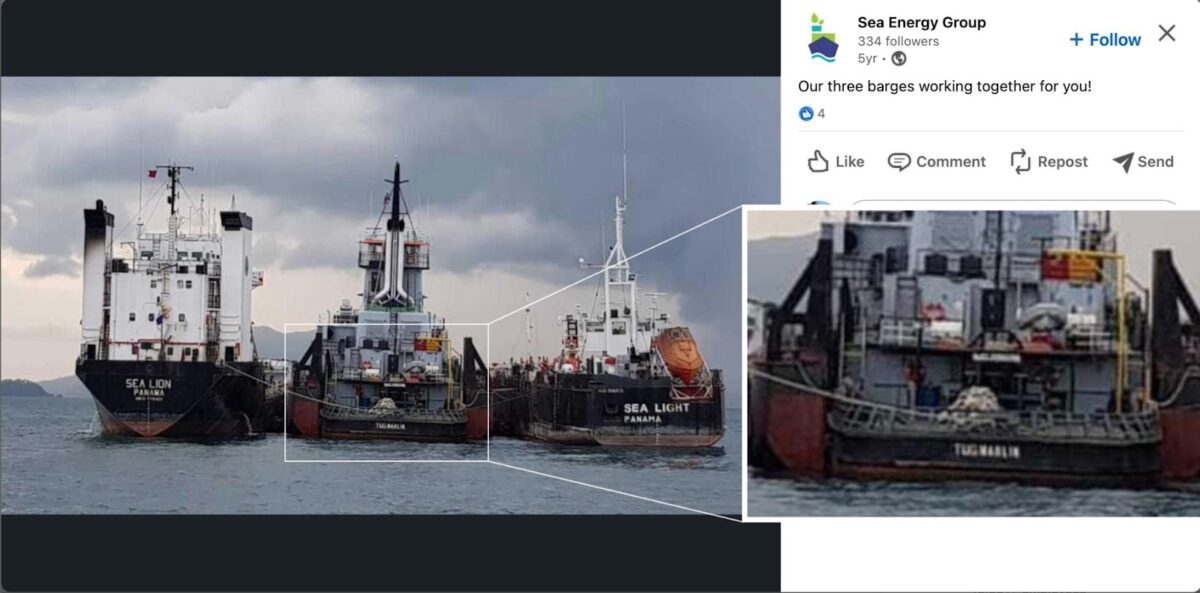
Another post on LinkedIn, on 19 October 2018, contains a video showing the Tug Marlin and the Gulfstream (Sea Marlin) leaving a dock.

Bellingcat geolocated this video to the PDVSA Puerto Miranda Terminal in Maracaibo, Venezuela. While the video was posted on October 19, 2018, satellite imagery shows that it was filmed earlier, possibly around 2016 to 2017, when the vessel was frequently docked at this pier.
During its time owned by Sea Energy Group, the Tug Marlin consistently transmitted AIS location information, showing it frequently visited PDVSA ports in Maracaibo and Amuay.
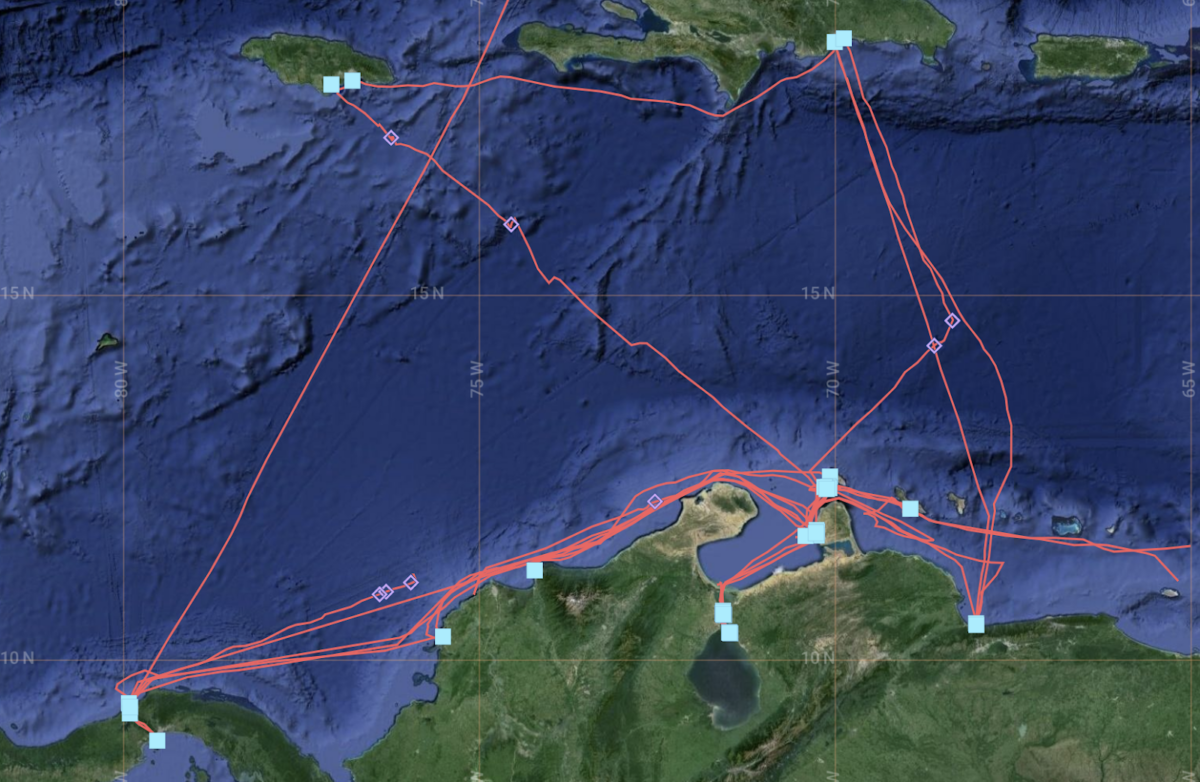
In 2020, 100,000 barrels of gasoline were auctioned off by a US federal court after suspicions that Sea Energy Group would transport it to Venezuela. Sea Energy chartered a vessel to carry fuel from Panama to Aruba, where it requested that the vessel offload it via ship-to-ship transfer to another vessel, the Beauty One, which frequently visited Venezuela.
As reported by Reuters, the owner of the chartered vessel “sought assurance from Sea Energy [that] the gasoline would not go to Venezuela, but did not receive a satisfactory response.” Despite Venezuela’s status as a major oil-producing country, its refinery capacity is limited, and Venezuela has struggled with fuel shortages in recent years.
In June 2020, the Sea Lion, another barge owned by the Sea Energy Group and pictured above, caused an oil spill near the Panama Canal. A court case reports that the Panama Maritime Authority found the Sea Lion “had multiple irregularities, including oil, fuel and wastewater leaks, poor bilge management and repeatedly ignoring the manuals that correspond to the prevention of fires and accidents.”
The Panama Maritime Authority described the Sea Lion as “a danger to navigation and the marine environment” and sanctioned Sea Energy with a revocation of its licence, though this was re-granted one year later. Shortly after the licence revocation, in October 2020, the Gulfstream/Sea Marlin arrived at ASTINAVE Shipyard, as previously reported by Bellingcat.
Finding the Solo Creed
Trinidad and Tobago authorities have identified a tugboat named the Solo Creed as the vessel that escorted the Gulfstream/Sea Marlin on its final, disastrous journey.
The only photograph of the Solo Creed on maritime analytics website Marine Traffic, where users can upload images of vessels, was posted on December 24th, 2023, just a few days before the tugboat and the Gulfstream/Sea Marlin departed on their final voyage. The photograph was uploaded by a user with the name “Melaj Offshore Corporation.”

Bellingcat verified the location of the image in Colón, between Muelle 3 and the small beach where the Gulfstream spent seven months laid up at an informal harbour. This is the same location where the barge’s final voyage began.
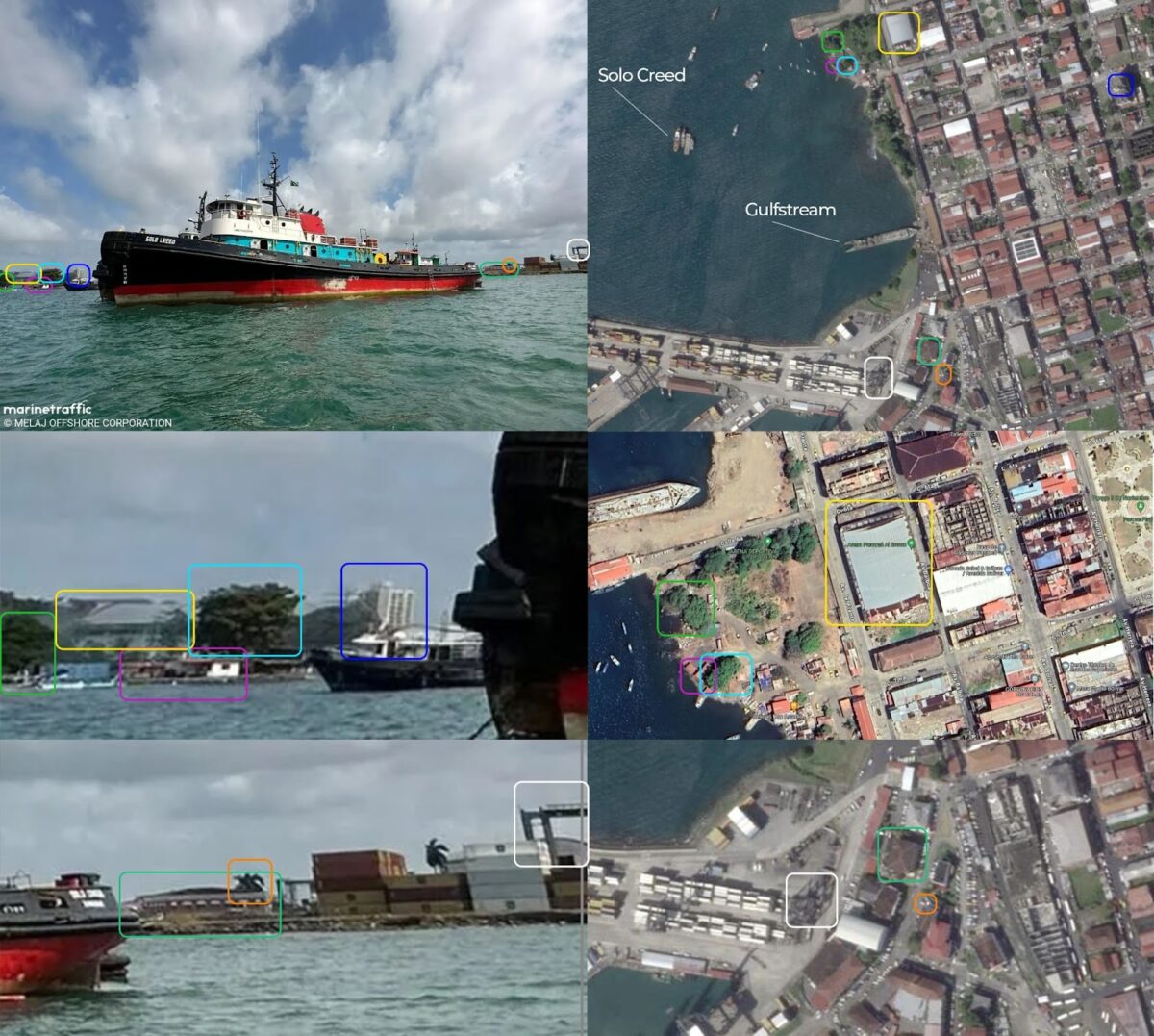
Turkish shipping management company Mahi Shipping, formally known as Mahinour Gida Denizcilik Ithalat Ihracat Sanayi Ve Ticaret LTD STI, lists the Solo Creed among the vessels it has classified on their website. Ship classification is the process whereby a vessel is certified for complying with relevant regulatory and maintenance standards.

“With regard to the administration of the Solo Creed, there is no information that any deficiency or flaw with that vessel had any relationship with the oil spill,” Mahi Shipping said, in an emailed statement. “We are sorry we have no resources to continue with this forth and back over a situation that is not in our hand or jurisdiction.”
On Friday, Tobago House of Assembly Chief Secretary Farley Augustine said in a press conference, “Those unanswered questions remain unanswered at this point. Such as, number one, who is the owner of the vessel that ran aground in Tobago and is leaking oil?” The people of Tobago are still waiting for an answer.
Additional research by Mikael Hoffman and members of Bellingcat’s Discord community.

